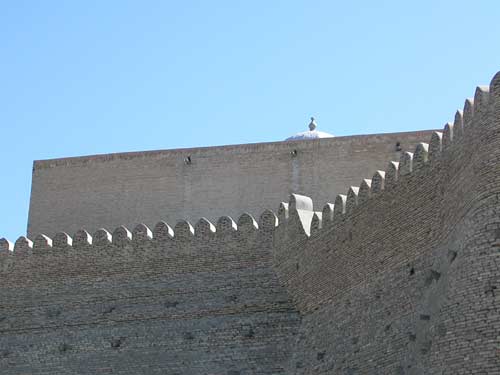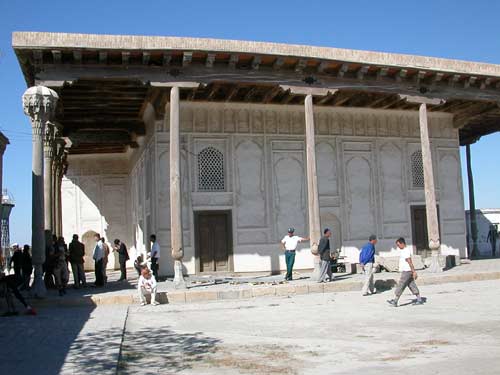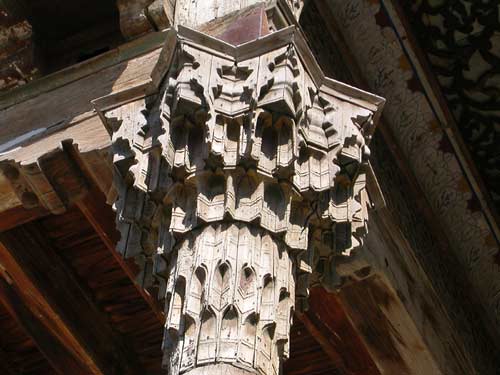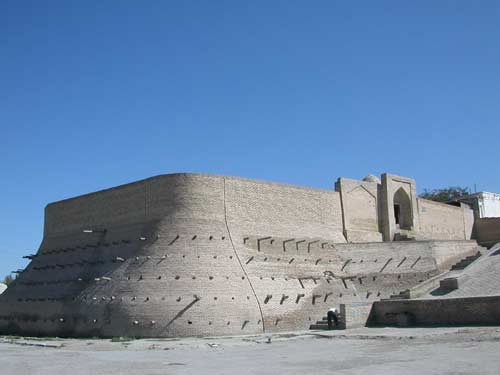|
Category
|
Ark Fortress
Ark - is a large earthen fortification in the western part of modern Bukhara. The plan is close to an irregular rectangle, slightly elongated in the direction from west to east. The total length of the wall of Ark is 789.60 m, the area - 3.96 hectares. Height from the Registan Square, where it is located, ranging from 16 to 20 meters. The front entrance to the Citadel architecture designed in the form of two columnar towers. At the top of the towers are connected by a gallery, over which there is a room with a terrace. The rise of the gate arch is a ramp ("dalon") or gradually rising path that leads through the indoor long corridor to the top of the mosque
And yet, the original creator of the citadel Narshahi calls the legendary hero of Persian epic “Shahnameh” Siyavush "Siyavush son of Kaykaus fled from his father, crossed the Jayhun river and came to Afrasiab. Afrasiab well received Siyavush, gave him his daughter Ferganiz and even they say, gave him all his possessions. Siyavush, thus obtaining temporary possession of Bukhara region, wished to remain here any recollection of his dominion, so he built this castle and lived there mostly. Envious managed to embroil Siyavush and Afrasiab, and Afrasiab killed Siyavush. In the same fortress, near the entrance through the eastern gate, the gate inside the straw sellers (they are also called Gurian gate), he was buried. Bukharian magicians for that reason are treated with great respect for this place, annually, on the day of the new year, before sunrise, every man, according to custom, stabs here in memory of Siyavush, one rooster. The residents of Bukhara is a song about the murder of Siyavush known in all areas, the musicians have composed them and sing their theme; reciters called these songs "Mages crying. " They say that before you pay for Siyavush his daughter, Afrasiab put a tricky condition. He pitched bovine skin and Siyavush ordered to build a palace on the ground, which would fit in this skin. But even trickier was Siyavush. He cut the skin into thin strips, the ends joined together, and within this circle built a palace.
Along the corridor leading from the main entrance to the mosque, there are facilities for water and sand, cells for prisoners ("obhana"). Here, under these facilities was a prison ("kanahana") for dangerous criminals.
In the Ark is a large complex of buildings, including a Childuhtaron mosque, which is connected with the legend of forty girls, who were tortured and thrown into the well. Unfortunately, most of the buildings inside the arch, a wooden frame building, was burnt by fire in 1920 Registan Square Registan Square, west of the Ark - in the past - the developed city center. It housed the office buildings, palaces, mosques and shopping section of the bazaar. On the territory of the area and was a hospital (Dar al-Shifa), where patients could receive medications ("dori") and dietary foods for medical treatment. The building resembled a hospital madrassas. There were wards for bed-ridden patient, outpatient, and pharmacy. In addition, doctors are trained. Zindan - an ancient prison
In Zindan was jailed not more than 40 (!) prisoners. In comparison with a population of Bukhara, this number was just ridiculous. It also says that the crime rate in Bukhara was extremely low. In Bukhara Zindan held debt, and violators of religious orders. Emirate of Bukhara was a state where religion was the highest authority, and, consequently, require strict compliance with all requirements of Islam, one of which included the performance of daily prayers fivefold ("Namozi panj vaqti"). Intentional deviation from religious duties carried in a severe penalty, up to the conclusion in Zindan. Source - Dmitry Paige. "Bukhara. Guide to the architectural and historical sites" |
 Ark fortress - the oldest monument in Bukhara - the citadel and residence of Bukhara rulers. Ark of archaeological data refer to the III с. before our era. The fortress overlooks the Registan Square symbol of greatness, the power of inaccessibility.
Ark fortress - the oldest monument in Bukhara - the citadel and residence of Bukhara rulers. Ark of archaeological data refer to the III с. before our era. The fortress overlooks the Registan Square symbol of greatness, the power of inaccessibility. The first information about Ark (Kuhandize - so called it earlier) contained in the "History of Bukhara" of Abu-Bakr Muhammad Narshahi (899-960): "When Bidun Bukhar-Khudat built this palace, he immediately broke up, how many times or renewed construction, she immediately destroyed ... Scientists have given a general consent to erect the building on the Council plan for the similarity of the constellation Ursa Major, on seven stone pillars. Indeed, when completed the building of the palace, at the scientists to plan, construction is not destroyed. "
The first information about Ark (Kuhandize - so called it earlier) contained in the "History of Bukhara" of Abu-Bakr Muhammad Narshahi (899-960): "When Bidun Bukhar-Khudat built this palace, he immediately broke up, how many times or renewed construction, she immediately destroyed ... Scientists have given a general consent to erect the building on the Council plan for the similarity of the constellation Ursa Major, on seven stone pillars. Indeed, when completed the building of the palace, at the scientists to plan, construction is not destroyed. " During the reign of Emir Shakhmurad was time for the Emirate of relative stability and prosperity. Emir Shahmurad nicknamed "Sinless Emir" produced the reconstruction of many of the old structures and creating new Ark structures. In particular, most likely with him, kept the gate arch gained its present appearance, and the building of the upper mosque (Juma Mosque) was rebuilt. Well-preserved building Juma Mosque has signs of more recent renovations related to the end of the XIX and early XX century.
During the reign of Emir Shakhmurad was time for the Emirate of relative stability and prosperity. Emir Shahmurad nicknamed "Sinless Emir" produced the reconstruction of many of the old structures and creating new Ark structures. In particular, most likely with him, kept the gate arch gained its present appearance, and the building of the upper mosque (Juma Mosque) was rebuilt. Well-preserved building Juma Mosque has signs of more recent renovations related to the end of the XIX and early XX century. On one wall of the Ark, probably with Emir Nasrullah (1826-1860), nicknamed the people for their cruelty, "Amir-kassob" ("Emir the butcher"), which once hung a large leather whip - a symbol of power of the Emir.
On one wall of the Ark, probably with Emir Nasrullah (1826-1860), nicknamed the people for their cruelty, "Amir-kassob" ("Emir the butcher"), which once hung a large leather whip - a symbol of power of the Emir. In Soviet times, Zindan of Bukhara served as a symbol of over throw despotic rulers of Central Asia. In reality, power, accusing the local rulers in the mistreatment of people, contained in the conclusion of a huge number of people.
In Soviet times, Zindan of Bukhara served as a symbol of over throw despotic rulers of Central Asia. In reality, power, accusing the local rulers in the mistreatment of people, contained in the conclusion of a huge number of people.














